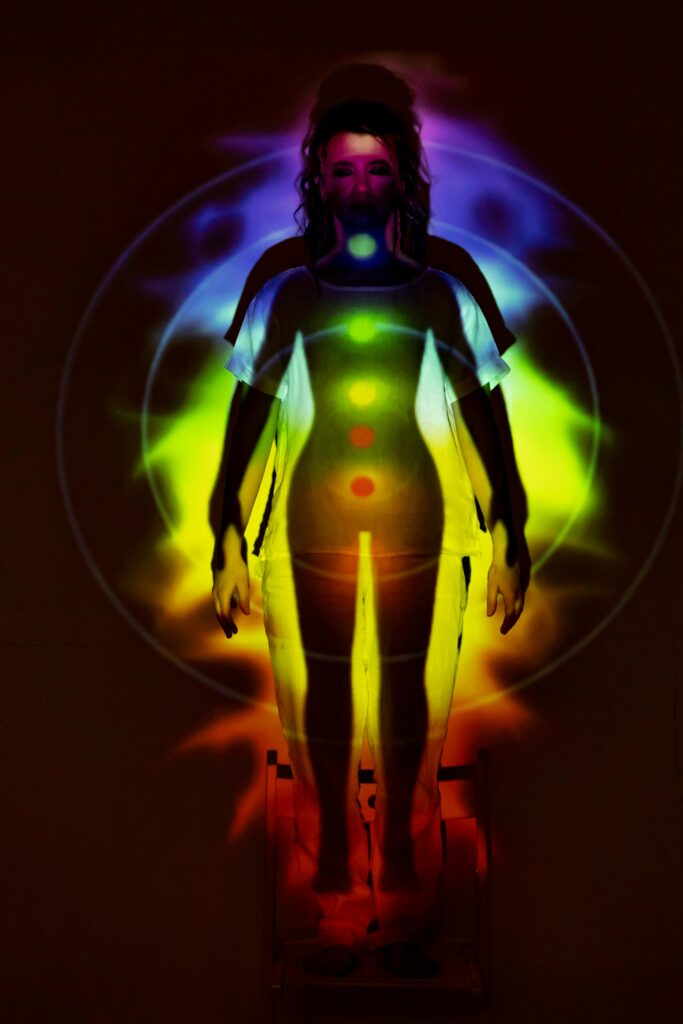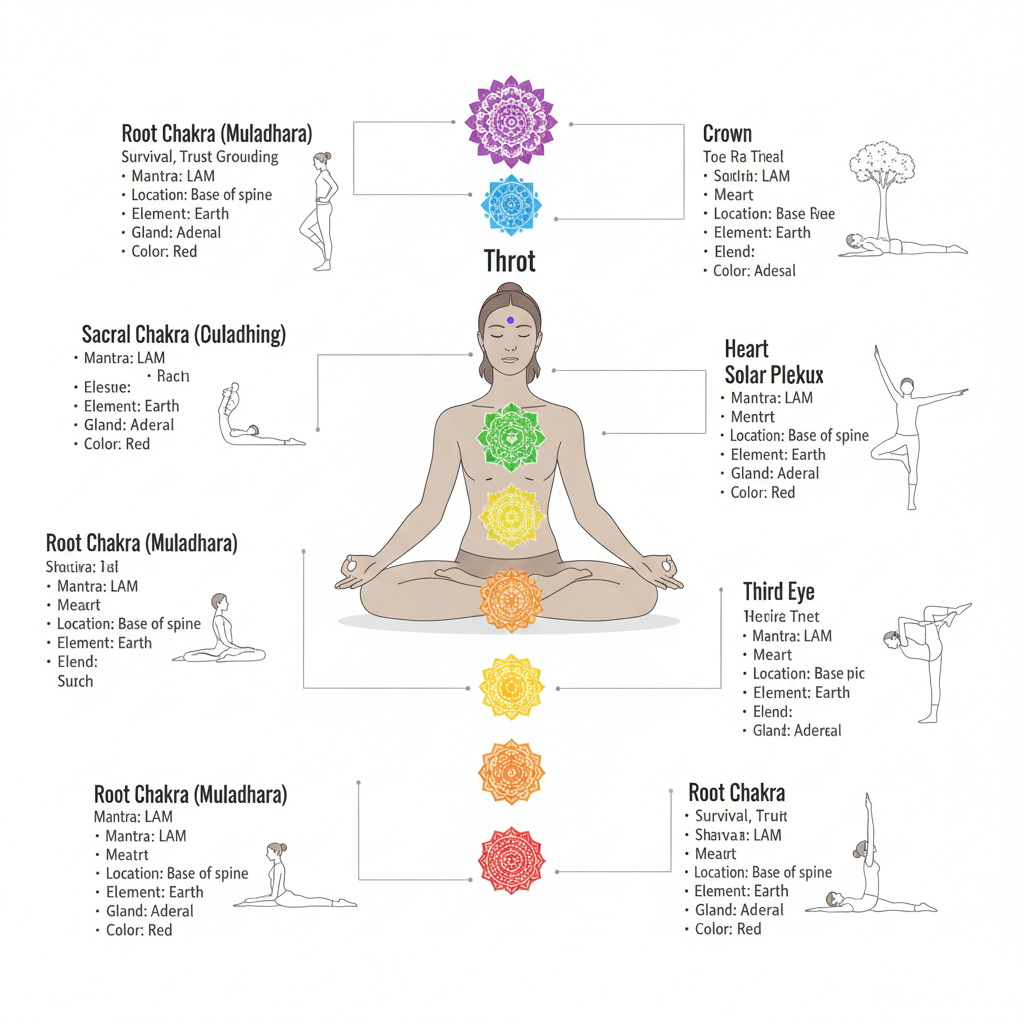A Beginner’s Guide to the 7 Chakras: Balance Your Energy for Well-Being
The chakra system represents one of humanity’s oldest and most comprehensive frameworks for understanding the intricate connection between your physical body, emotional state, and spiritual vitality. From chronic stress and unexplained fatigue to relationship challenges and creative blocks, the ancient wisdom of learning to balance chakras offers transformative solutions that modern medicine often overlooks. These powerful energy centers, spinning silently along your spine, influence everything from your immune function to your ability to express authentic emotions. Learning about the chakra system empowers you to decode your body’s energetic language and create profound healing that radiates through every dimension of your life.

What Are Chakras and Why Does the Chakra System Matter?
Chakras are spinning energy centers located along your spine as indicated in the image above, and that regulate the flow of life force energy, or prana, throughout your body. The chakra system originated in India between 1500 and 500 BC in ancient texts called the Vedas, making it one of the oldest holistic health systems in human history. The word “chakra” comes from Sanskrit and literally means “wheel” or “disk,” reflecting how these energy centers continuously rotate and draw in vital energy.
Chakras are thought to vitalize the physical body and are associated with interactions of a physical, emotional, and mental nature. When the seven chakras function optimally, energy flows freely through your body, creating a state of balance that supports your overall health. However, when blockages occur in one or more of the seven chakras, you may experience physical ailments, emotional disturbances, or spiritual disconnection. Understanding the chakra system allows you to identify these imbalances and take proactive steps toward healing.
The classical chakra system consists of seven main chakras arranged vertically along the axial channel, though some traditions recognize additional energy points throughout the body. Each chakra corresponds to specific organs, glands, emotions, and spiritual qualities, creating an intricate map of your entire being. Chakra shapes and symbols offer further insight into this intricate map and its healing energies. By working with your chakras, you tap into an ancient wisdom that bridges the gap between mind, body, and spirit.
Where Are Your Seven Chakras Located?
The seven chakras extend from the base of your spine to the crown of your head, forming a vertical energy pathway through your body’s center. Each of the seven chakras occupies a specific location that corresponds to major nerve plexuses and endocrine glands in your physical body. The primary chakras located down the spine may correspond to the central nervous system, and their connection to specific aspects of health may relate to different nerve plexuses.
The Root Chakra (Muladhara) sits at the base of your spine, grounding you to the earth and providing your foundation for survival and security. Moving upward, the Sacral Chakra (Svadhisthana) resides in your lower abdomen, just below your navel, governing creativity and sexuality. The Solar Plexus Chakra (Manipura) is located in your upper abdomen, around your diaphragm, serving as your personal power center. The below figure shows the positions of different chakras and their functions.

Your Heart Chakra (Anahata) occupies the center of your chest, acting as the bridge between your lower physical chakras and your upper spiritual chakras. The Throat Chakra (Vishuddha) sits at your throat, enabling authentic communication and self-expression. The Third Eye Chakra (Ajna) is positioned between your eyebrows, connecting you to intuition and inner wisdom. Finally, the Crown Chakra (Sahasrara) rests at the top of your head, linking you to universal consciousness and spiritual enlightenment.
The Unique Functions of Each of the Seven Chakras
Each of the seven chakras performs distinct functions that influence different aspects of your physical, emotional, and spiritual well-being. Understanding these functions helps you identify which chakras need attention when you experience specific challenges in your life.
Your Root Chakra establishes your sense of safety, stability, and groundedness in the physical world. It governs your basic survival needs, including food, shelter, and financial security, while also connecting you to your physical body and the earth beneath you. When this chakra functions properly, you feel secure, stable, and confident in meeting your basic needs.
The Sacral Chakra regulates your creativity, sexuality, pleasure, and emotional expression. It drives your passion for life and your ability to experience joy, intimacy, and creative flow. Your Solar Plexus Chakra controls your personal power, self-esteem, and willpower, serving as the seat of your identity and confidence. This chakra determines how you assert yourself in the world and maintain healthy boundaries.
Your Heart Chakra represents your ability to love and connect to others, bridging the gap between your upper and lower chakras. It governs compassion, forgiveness, and emotional balance, allowing you to give and receive love freely. The Throat Chakra enables clear communication, authentic self-expression, and the ability to speak your truth with confidence.
Your Third Eye Chakra enhances your intuition, imagination, and inner vision, helping you perceive beyond physical reality and access deeper wisdom. The Crown Chakra helps you function in a more enlightened way, cultivate self-mastery, and find a sense of connection with all. It connects you to universal consciousness and your highest spiritual potential.
How the Chakra System Affects Your Physical and Emotional Body
The chakra system directly influences your physical health, emotional state, and mental clarity through its connection to your nervous system and endocrine glands. When you balance chakras and energy flows freely, you experience optimal health, emotional stability, and mental sharpness. However, imbalances in your chakras manifest as specific physical symptoms and emotional patterns that signal which energy centers need attention.
When you balance chakras properly and maintain alignment, energy flows beautifully through the body, bringing health and well-being at every level, but blockages in any chakra cause physical ailments, emotional imbalances, or disconnection with spirit. For example, an imbalanced Root Chakra may cause lower back pain, digestive issues, and feelings of insecurity or anxiety about money and survival. A blocked Sacral Chakra can lead to reproductive issues, lower back problems, and emotional numbness or difficulty experiencing pleasure.
Solar Plexus Chakra imbalances often manifest as digestive disorders, weight issues, and low self-esteem or control issues. Heart Chakra blockages may result in cardiovascular problems, immune deficiencies, and difficulty forming meaningful relationships or experiencing compassion. Throat Chakra problems can be seen through voice and throat issues, as well as problems with teeth, gums, and mouth, along with dominating conversations, gossiping, or speaking without thinking.
Third Eye Chakra imbalances affect your vision, cause headaches, and create mental fog or difficulty trusting your intuition. Crown Chakra blockages can lead to neurological issues, sensitivity to light and sound, and feelings of spiritual disconnection or inability to find meaning in life. By recognizing these patterns, you can identify which chakras need healing work and take targeted action to restore balance.
Practical Techniques to Balance Chakras for Optimal Well-Being
Learning to balance chakras requires consistent practice using various techniques that clear blockages and restore healthy energy flow throughout your system. You can choose from multiple approaches based on your preferences, lifestyle, and specific needs, combining different methods for optimal results.
Meditation and visualization serve as powerful tools when you balance chakras. Sit comfortably, focus on each chakra location, visualize its associated color, and imagine the energy center spinning smoothly and radiating vibrant light. Practice breathwork techniques that direct prana through your chakras, such as alternate nostril breathing or deep belly breathing, to clear stagnant energy and revitalize each center.
Yoga poses target specific chakras through physical postures that stimulate energy flow. Practice grounding poses like Mountain Pose for your Root Chakra, hip openers for your Sacral Chakra, and heart-opening backbends for your Heart Chakra. Incorporate chakra-specific affirmations into your daily routine, repeating positive statements that align with each energy center’s qualities. Sound healing with specific mantras, singing bowls, or tuning forks creates vibrations that resonate with each chakra’s frequency.
Chakra color therapy uses the vibrational frequencies of colors to balance chakras, as each of the seven chakras relates to specific vibration and frequency. Surround yourself with each chakra’s color through clothing, crystals, or environmental decor. Work with corresponding crystals by placing them on chakra locations during meditation or carrying them throughout your day. Just as flower essences capture vibrational energy to support emotional and spiritual healing, essential oils, nutrition choices, and spending time in nature also support efforts to balance chakras by addressing each center’s specific energetic needs through their unique frequency signatures.
The Ancient History and Traditional Wisdom of the Chakra System
The chakra system originated in India between 1500 and 500 BC in the oldest text called the Vedas, with evidence of chakras also found in the Shri Jabala Darshana Upanishad, the Cudamini Upanishad, the Yoga-Shikka Upanishad, and the Shandilya Upanishad. These ancient texts describe the seven chakras as vital components of the subtle body, an energetic template that interpenetrates and extends beyond your physical form.
Traditional teachings passed down through generations of yogis, healers, and spiritual masters have preserved and refined chakra knowledge over millennia. What began as sacred teachings in the ancient Vedas—texts dating back over 3,000 years—has evolved into a fascinating intersection of spirituality and science, as modern research uncovers surprising connections between these energy centers and the body’s endocrine glands and central nervous system. While Western science initially dismissed the chakra system as pseudoscience, contemporary researchers now recognize intriguing parallels between chakra locations and major nerve plexuses.
Different spiritual traditions have developed their own interpretations of working with the seven chakras. Tantric Buddhism emphasizes the role of chakras in kundalini awakening, where dormant spiritual energy rises through each center toward enlightenment. Traditional Chinese Medicine’s meridian system shares similarities with nadis, the energy channels through which prana flows between chakras. Ayurvedic medicine integrates practices to balance chakras into its holistic healing protocols, recognizing that physical disease often stems from energetic imbalances. This holistic understanding mirrors how flower essences work on vibrational frequencies to restore emotional and physical harmony, demonstrating the universal principle that healing requires addressing both energetic and physical dimensions simultaneously.
Your Path Forward: Integrating the Chakra System into Daily Life
Understanding the chakra system provides you with a comprehensive framework for achieving holistic wellness that addresses your physical, emotional, and spiritual needs simultaneously. By regularly assessing your chakra health and implementing balancing practices, you create sustainable well-being that radiates through every aspect of your life.
Start your journey with the seven chakras by observing which areas of your life feel blocked or unbalanced. Notice physical symptoms, emotional patterns, and life circumstances that indicate specific chakra imbalances. Begin with simple daily practices like morning chakra meditation, wearing colors that correspond to chakras needing support, or using affirmations throughout your day. As you become more familiar with your energy system, you’ll develop intuitive awareness of when certain chakras need attention.
Remember that working to balance chakras is a lifelong practice rather than a quick fix. Your energy system responds to life experiences, stress, trauma, relationships, and personal growth, requiring ongoing attention and care. Approach your chakras with patience, curiosity, and compassion, honoring the profound wisdom they contain. By maintaining balanced chakras, you unlock your full potential for health, happiness, creativity, connection, and spiritual evolution. Embrace this ancient knowledge as your personal roadmap to living a vibrant, purposeful, and harmonious life.
FAQ
Q: What is the chakra system? A: The chakra system consists of seven main energy centers located along your spine that regulate the flow of life force energy throughout your body, influencing your physical, emotional, and spiritual well-being.
Q: Where are the seven chakras located in the body? A: The seven chakras extend from the base of your spine (Root Chakra) to the crown of your head (Crown Chakra), including locations at your lower abdomen, solar plexus, heart, throat, and between your eyebrows.
Q: How do I balance chakras effectively? A: Balance chakras through meditation, yoga, breathwork, visualization, sound healing, chakra color therapy, crystal healing, and affirmations specific to each energy center.
Q: What happens when your chakras are blocked? A: When chakras are blocked, you may experience physical symptoms, emotional imbalances, and life challenges specific to each chakra’s function, such as anxiety, digestive issues, relationship problems, or lack of creativity.
